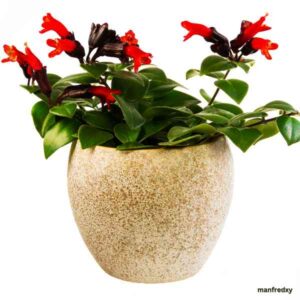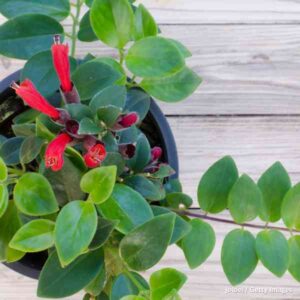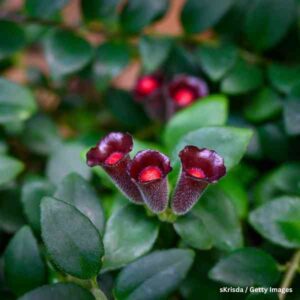Master the care of lipstick plants for vibrant growth and blooms year-round:
The lipstick plant (Aeschynanthus radicans) is a tropical beauty that earns its name from its tubular red blooms resembling a tube of lipstick. Known for its trailing, glossy green leaves and vibrant flowers, this plant is a popular choice for hanging baskets and shelves, adding a burst of color to indoor spaces.
Native to the warm, humid regions of Southeast Asia, the lipstick plant thrives indoors when its environmental needs are met. With the right care, it can produce flowers throughout the year. In this guide, we’ll take a deep dive into everything you need to know about growing and maintaining a healthy lipstick plant.


Lipstick Plant Overview
- Common Name: Lipstick plant
- Botanical Name: Aeschynanthus radicans
- Family: Gesneriaceae
- Plant Type: Tropical perennial
- Mature Size: Trails up to 2–3 feet long
- Sunlight Requirements: Bright, indirect light
- Soil Type: Well-draining, aerated potting mix
- Soil pH: Slightly acidic (6.0–6.5)
- Bloom Time: Year-round, with peak blooming in summer
- Flower Color: Red
- Hardiness Zones: 10–11 (grown as a houseplant in most areas)
- Native Area: Southeast Asia

Hairy Calyx Tubes of the Lipstick Plant
Lipstick Plant Care
The lipstick plant is relatively low-maintenance when its natural tropical environment is mimicked indoors. It requires bright but indirect sunlight, a warm environment, and consistent humidity to thrive.
Light Requirements
Lipstick plants flourish in bright, indirect light. Direct sunlight can scorch their leaves, while low light can cause sparse foliage and fewer flowers. For best results, place your plant near an east-facing window, where it can receive morning light that is gentle and filtered.
If natural light is insufficient, you can supplement it with grow lights. Ensure the plant receives 12–16 hours of light daily for optimal growth and blooming.
Soil and Potting Mix
In its native habitat, the lipstick plant grows as an epiphyte, meaning it attaches to trees and other plants, thriving in minimal soil. To mimic these conditions, use a well-draining potting mix that retains some moisture but does not stay waterlogged.
A mix containing peat moss, perlite, and coarse sand works well. Alternatively, orchid mix blended with standard potting soil can provide the aeration and drainage the plant needs.
Watering the Lipstick Plant
Proper watering is crucial for keeping your lipstick plant healthy.
- During the Growing Season: Keep the soil consistently moist but not soggy. Water when the top inch of soil feels dry to the touch.
- During Winter: Reduce watering, allowing the soil to dry out more between waterings, as the plant’s growth slows during this time.
Always use a pot with drainage holes to prevent water from accumulating at the bottom, which can lead to root rot.
Temperature and Humidity Needs
Lipstick plants thrive in warm, humid conditions. Maintain indoor temperatures between 65°F and 75°F (18°C to 24°C), and avoid exposing the plant to temperatures below 50°F (10°C). Sudden drafts or temperature fluctuations can cause stress, leading to leaf drop.
As a tropical plant, the lipstick plant loves humidity. If the air in your home is dry, increase humidity by:
- Placing the plant near a humidifier.
- Setting the pot on a pebble tray filled with water (ensure the pot does not sit directly in the water).
- Grouping the lipstick plant with other humidity-loving plants.
Regular misting can also help maintain adequate moisture levels around the plant.
Fertilizer for Lipstick Plants
Feed your lipstick plant during the active growing season (spring and summer) with a balanced, water-soluble fertilizer. Dilute the fertilizer to half the recommended strength and apply it every two weeks.
Avoid over-fertilizing, as it can damage the plant’s roots and foliage. During the dormant period in winter, hold off on fertilization.
Pruning and Maintenance
Pruning is essential to maintain the lipstick plant’s shape and encourage healthy growth. Trim leggy or overgrown stems and remove any yellow or damaged leaves regularly.
Pruning not only helps the plant retain its compact, bushy appearance but also promotes more prolific flowering by redirecting energy to new growth.
Propagating Lipstick Plants
Lipstick plants are easy to propagate, making them a great choice for sharing with friends or expanding your plant collection.
- Select a Stem: Choose a healthy stem with several nodes.
- Take a Cutting: Use clean, sharp scissors to cut a 4–6 inch segment just below a node.
- Remove Lower Leaves: Strip the leaves from the lower portion of the cutting.
- Place in Water or Soil: Place the cutting in water or a moist potting mix.
- Provide Bright, Indirect Light: Keep the cutting in a warm spot with indirect light.
Roots should develop within 2–4 weeks. Once the cutting is well-rooted, it can be transplanted into a pot with fresh soil.
Common Problems and Solutions
- Leaf Drop: This can result from overwatering, sudden temperature changes, or insufficient light. Ensure proper care conditions to prevent this issue.
- Pests: Watch for aphids, spider mites, and mealybugs. Treat infestations promptly with insecticidal soap or neem oil.
- No Flowers: If your lipstick plant is not blooming, it may not be receiving enough light. Move it to a brighter location.
Types of Lipstick Plants
There are several varieties of lipstick plants, each with unique characteristics:
- ‘Black Pagoda’: Known for its dark, patterned leaves and vibrant red flowers.
- ‘Twister’: Features curling leaves and bright blooms, giving it a whimsical appearance.
- ‘Mona Lisa’: Offers larger flowers and a more vigorous growth habit.
Repotting the Lipstick Plant
Repot your lipstick plant every 2–3 years or when the roots begin to outgrow the pot. Choose a container that is one size larger and refresh the soil mix to ensure optimal growth conditions.
Conclusion
The lipstick plant is a stunning addition to any indoor garden, with its cascading vines and vibrant blooms adding a tropical touch to your home. By providing the right light, water, temperature, and humidity, you can enjoy a thriving, blooming lipstick plant all year round. With regular care and attention, this unique houseplant will become a showstopper in your collection.
FAQs About Lipstick Plants
Q: How often should I water my lipstick plant?
A: Water your lipstick plant when the top inch of soil feels dry. During the growing season (spring to fall), keep the soil consistently moist but not soggy. In winter, reduce watering, allowing the soil to dry out more between waterings.
Q: Why is my lipstick plant not blooming?
A: A lack of blooms is often due to insufficient light. Ensure your plant is placed in a spot with bright, indirect sunlight. Over-fertilizing, poor pruning habits, or inconsistent watering can also inhibit flowering.
Q: Can I grow a lipstick plant outdoors?
A: Lipstick plants can be grown outdoors in USDA hardiness zones 10–11. In other regions, they are best kept as houseplants. If grown outdoors, ensure they are in a shaded or partially shaded area to protect them from direct sunlight.
Q: What pests should I watch for on my lipstick plant?
A: Common pests include aphids, spider mites, and mealybugs. Regularly inspect your plant for signs of pests, such as webbing, sticky residue, or discolored leaves. Use neem oil or insecticidal soap to treat infestations.
Q: How do I increase humidity for my lipstick plant?
A: You can increase humidity by misting the plant regularly, using a pebble tray filled with water, grouping it with other plants, or placing a humidifier nearby.
Q: Can I propagate lipstick plants in water?
A: Yes, lipstick plants propagate well in water. Simply place a stem cutting with its lower leaves removed into a container of water. Once roots develop, transfer the cutting to a pot with fresh soil.
Q: What type of pot should I use for my lipstick plant?
A: Use a pot with drainage holes to prevent water from accumulating at the bottom, which can lead to root rot. Hanging pots or baskets work well since the plant’s trailing vines are its main visual appeal.
Q: How often should I fertilize my lipstick plant?
A: Fertilize your lipstick plant every two weeks during the growing season (spring and summer) using a balanced, water-soluble fertilizer diluted to half strength. Avoid fertilizing in winter when the plant’s growth slows.
Q: Why are my lipstick plant’s leaves turning yellow?
A: Yellowing leaves can result from overwatering, underwatering, or nutrient deficiencies. Check your watering schedule and ensure the plant is receiving adequate light and nutrients.